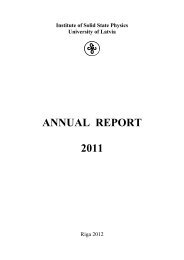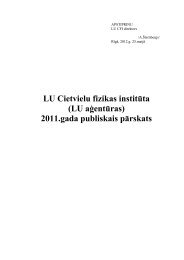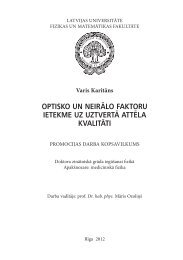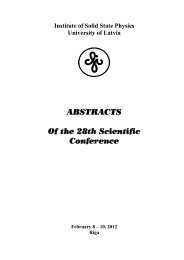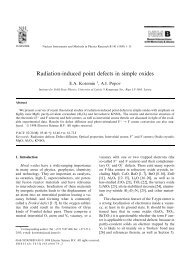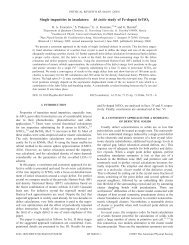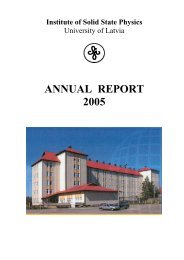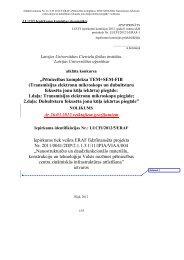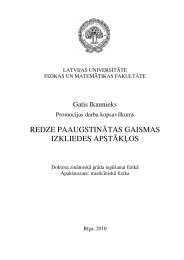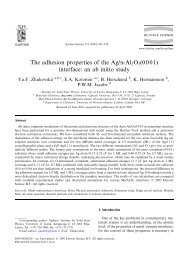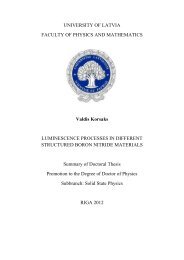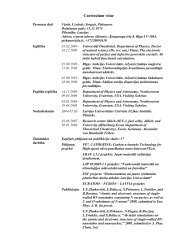Annual Report 2012 - Latvijas Universitātes Cietvielu fizikas institūts
Annual Report 2012 - Latvijas Universitātes Cietvielu fizikas institūts
Annual Report 2012 - Latvijas Universitātes Cietvielu fizikas institūts
You also want an ePaper? Increase the reach of your titles
YUMPU automatically turns print PDFs into web optimized ePapers that Google loves.
Density and dielectric properties for different compositions<br />
Table 1<br />
Composition<br />
Density<br />
g/cm 3<br />
Dielectric<br />
permittivity ε<br />
(room T)<br />
Dielectric<br />
loss tanδ<br />
(room T)<br />
T max<br />
(C°)<br />
S4-1BT 4.51 1400 0.043 305 1.34<br />
S4-2BT 4.44 1240 0.652 270 1.45<br />
S4-4BT 4.34 1380 0.727 178 1.73<br />
S7-1BT 4.31 1800 0.100 245 1.39<br />
S7-2BT 4.34 940 0.490 211 1.57<br />
S7-4BT 4.43 1400 0.549 129 1.76<br />
PHASE TRANSITIONS AND PHYSICAL PROPERTIES IN<br />
Na 1/2 Bi 1/2 TiO 3 -BaTiO 3 SOLID SOLUTIONS<br />
M.Dunce, E.Birks, M.Antonova, A. Plaude, R. Ignatans<br />
Na 1/2 B 1/2 TiO 3 and its solid solutions attract interest mostly as an alternative for<br />
nowadays widely used lead-containing ferroelectric, use of which is gradually limited<br />
due to ecological considerations.<br />
Na 1/2 B 1/2 TiO 3 solid solutions with BaTiO 3 or (1-x)NBT-xBT show good<br />
piezoelectric properties. Most of the studies of (1-x)NBT-xBT are focused on the region<br />
around the morphotropic phase boundary, which is observed at BT concentration<br />
0.05≤x≤0.07. There is very little information about the compositions with higher BT<br />
content.<br />
In this work dielectric properties, polarization and x-ray diffraction are studied for<br />
NBT-BT solid solutions in a concentration range above the morphotropic phase<br />
boundary. Parameters, characterizing crystallographic structure and phase transition, are<br />
determined depending on the ratio of components of the solid solution. The results show<br />
that that all the studied compositions have tetragonal structure with maximal<br />
tetragonality slightly above the morphotropic phase boundary. In a wide concentration<br />
range ferroelectric relaxor properties are observed with a spontaneous transition to<br />
ferroelectric state at a temperature below the maximum of dielectric permittivity.<br />
Stability of the relaxor state decreases with increasing BaTiO 3 concentration, but only<br />
for compositions with low Na 1/2 Bi 1/2 TiO 3 content the normal ferroelectric-paraelectric<br />
phase transition, which is characteristic to pure BaTiO 3 , occurs. The change of<br />
diffuseness of the temperature dependence of dielectric permittivity is studied, using the<br />
power law. Attention is paid also to the concentration dependence of the thermal<br />
hysteresis. Mechanisms, which influence the change of the phase transition character<br />
and promote the appearance of the relaxor state, are discussed. The phase diagram of (1-<br />
x)Na 1/2 Bi 1/2 TiO 3 -xBaTiO 3 is revised.<br />
Special attention is paid to the phase coexistence region in the tetragonal side from<br />
the morphotropic phase boundary. The x-ray diffraction results show that the 1 st order<br />
ferroelectric phase transition, determined from a jump at temperature dependence of<br />
dielectric permittivity, is located inside the coexistence region of cubic and tetragonal<br />
phases and is below the temperature, where tetragonality disappears. At low BaTiO 3<br />
concentrations phase transition into ferroelectric state at cooling is slowly approached in<br />
time and is smeared over large temperature range. Rietveld method, applied for more<br />
precise evaluation of phase content, reveals large local deformations inside the<br />
ferroelectric phase.<br />
γ<br />
31



